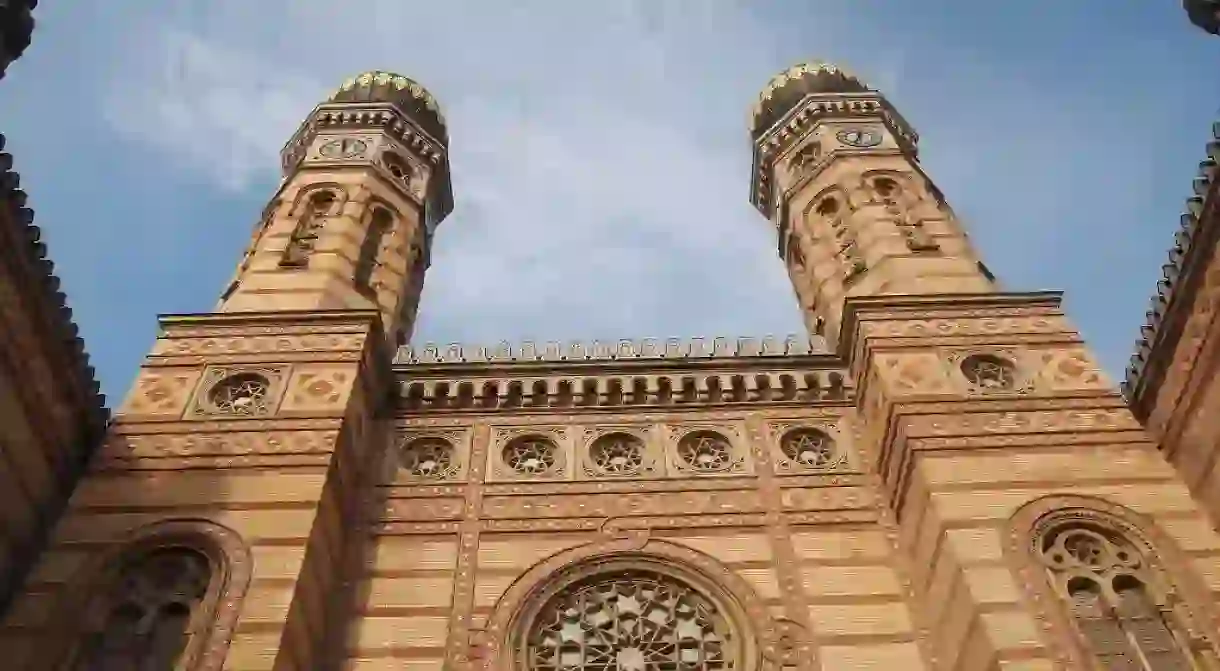Stunning Masterpieces You Can Only See in Budapest

Anyone hoping to catch a glimpse of artistic and architectural masterpieces while in Budapest is in luck. The city is home to a number of epic buildings and works of art that cannot be found anywhere else! Check out these ten masterpieces you can only see in the Hungarian capital.
Frescoes in the Alexandra Bookcafé by Karoly Lotz
Cafe, European

Not just a great place to enjoy a coffee in Budapest, the Alexandra Bookcafé is also home to stunning frescoes by Hungarian artist Karoly Lotz, who also lends his name to the room in which the café is located: Lotz Hall. Look up while enjoying your coffee, and you’ll notice Renaissance-style paintings adorning the entire ceiling.
Parisi Udvar by Miksa Róth
Memorial

A master of stained glass, Hungarian artist Miksa Róth lent his skills to a number of spaces within the city. The roof of Parisi Udvar, a covered passage in the center of Budapest, is one such space: decorated with stained glass, a hexagonal dome is the star of the show. As it forms part of the city’s architecture, this is a masterpiece that can only be seen where it stands! More of his work can be found at his former home, which has been turned into the Miksa Róth Memorial House, displaying some of his best works from mosaics to stained glass.
The Churning Woman by Mihaly Munkacsy
Museum
Born in 1944 in the then Hungarian town of Munkács, painter Mihaly Munkacsy would go on to become one of the country’s most renowned artists. His works were centered around genre art and realism; he often painted scenes from peasant life, and became known for his technical skill and ability to convey emotion in his works. The Churning Woman was painted in 1873, during a dark time in the artist’s life: the somber colors and expression given to the woman in the image convey a sense of despair. The painting can be found today in the Hungarian National Gallery, along with a number of other works by the artist.
Gresham Palace
Spa Hotel, Hotel

Now standing as the Four Seasons Hotel Gresham Palace, this Art Nouveau building is one of the city’s masterpieces for its unique architectural style. The building was designed by architects Szigmond Quittner and Joszef Vago in 1906 and was refurbished during the 1990s on the condition that its original Art Nouveau architecture be retained.
Picnic in May by Pal Szinyei Merse
Museum

Known for his association with the plein air movement – in which artists painted outdoors, creating works showing what they saw at the time of painting – Szinyei Merse was born in Hungary in 1845. One of his most well-known works, Picnic in May, can today be seen at the Hungarian National Gallery. However, when it was originally painted in 1873 the work was criticized and rejected by the Hungarian National Museum. It wasn’t until the 1890s that the painting received the recognition it still enjoys to this day.
Budapest Zoo and Botanical Garden
Botanical Garden, Zoo

A masterpiece of architecture, Budapest’s Zoo was founded in 1866, making it one of the oldest in Europe. Hungarian architect Károly Kós designed many of the zoo’s buildings in the art nouveau style and today the zoo is considered one of Budapest’s most notable pieces of architecture, however is often overlooked in favor of more centrally located buildings.
The Chain Bridge
Bridge

No trip to Budapest would be complete without a visit to the Chain Bridge: connecting Buda and Pest, it was the city’s first permanent bridge across the Danube and regarded as a masterpiece of engineering when it was opened in 1849. The pillars are the only original aspect: the rest of the bridge was rebuilt after being blown up during World War II.
Hungarian Parliament Building
Building

As one of the largest parliament buildings in the world, this architectural wonder is worth a trip if only to admire its overwhelming scale. The Gothic Revival architecture is also worth admiring: its creation was overseen by architect Imre Steindl, who beat off stiff competition to win the right to design the new Hungarian Parliament Building in 1885.
Breakwater at Trouville, Low Tide by Claude Monet
Museum

One of the most prolific figures of French Impressionism, Claude Monet created a number of works throughout his lifetime that would go on to become celebrated across the world. Known for his ability to convey color and light through his paintings, he was also renowned for his skill at painting water. The oil painting Breakwater at Trouville, Low Tide is one such example of this, capturing a calm yet transient moment on canvas. Usually on display at the Museum of Fine Arts, it can currently be viewed at the Hungarian National Gallery while the former is under renovation.
Dohány Street Synagogue
Building, Church, Memorial, Museum, Park, Synagogue

The second largest synagogue in the world, this impressive building in Budapest’s Jewish District gains a place on this list for its intricately decorated exterior, stunning interior, and the sheer scale of the building. It functions as both a place of worship and home to the Hungarian Jewish Museum and was constructed in the Moorish Style in 1859, by Viennese architect Ludwig Förster.













